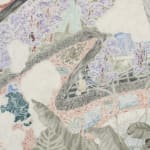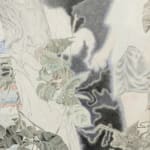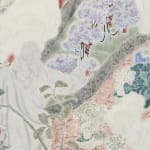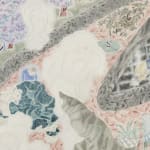Su Huang-Sheng 苏煌盛
Hot Valley in Beitou 热谷, 2019
Mineral pigment and ink on paper
矿物颜料、墨、麻纸
矿物颜料、墨、麻纸
37 3/4 x 148 7/8 in
96 x 378 cm
96 x 378 cm
Copyright The Artist
Further images
When Su Huang-Sheng arrived in New York for an artist residency program, he became curious about the plumes of steam coming through the manhole covers on the street. It evoked...
When Su Huang-Sheng arrived in New York for an artist residency program, he became curious about the plumes of steam coming through the manhole covers on the street. It evoked in him visual memories of the familiar environment around his studio in Beitou—a district to the north of downtown Taipei famous for its rich geothermal resources. In his Hot Valley in Beitou (2019), hot steam rising from the ground becomes a repeated theme throughout the central vista of the composition. Executed in his fine gongbi or “meticulous” brushwork using the baimiao or “outline” technique, Su’s rising steam resembles the auspicious clouds seen in traditional gongbi paintings. This visual motif, however, starts out as neither steam nor clouds but as smoke rising from the lit cigarette of Su’s young male protagonist shrouded in the dense woods to the right of the central scene. Three completely different natural phenomena—cigarette smoke, geothermal steam and floating clouds—Su connects through a shared formal depiction, thereby creating a pictorial motif that not only unifies the different spatial perspectives structuring the composition but also links personal action (smoking a cigarette), natural phenomena (geothermal heat), and cultural metaphor (auspicious clouds) into a chain of interconnected themes.
In terms of composition, Su divides the painting into three sections through the placement of three stout trunks in the viewer’s immediate foreground. The first section to the right shows an enclosed and intimate space where a headless youth is smoking. The size of the figure and its surroundings suggests a close-up viewing distance, as if the viewer is standing right in front of the boy between the first two trees. As our eye follows the smoke rising from the lit cigarette, we suddenly realize that the white whips have become a cloud and find ourselves high up in the sky looking down on an exquisite garden unfolding along a meandering stream. The size of the figures, trees and plants are all reduced as we zoom out and view the scene from afar and from above. Following the stream’s path, we encounter a figure in yellow lounging on a bench, a raptor perched in the high branches of a tree, a second figure in blue, head hung perhaps in melancholic daydream, and a statue seen from above and behind of a robed, long-haired figure (perhaps Christ), arms opened in an embracing gesture of compassion. Magically, the meandering stream turns into a winding path as the viewer continues through the fantastical garden until he or she exits from the upper left corner where the path, partially hidden behind the third foreground tree trunk, transforms, yet again, into an abstract black line resembling an electric wire (as seen from up close) not unlike the black lines intertwined in the garden trees (as seen from a distance) far below.
Zooming in again from a foreground perch, the viewer now finds him or herself looking from above at the corner of a rooftop balcony, probably from the window or balcony of a nearby building. Such dramatic change of pictorial space provides the viewer with a nearly theatrical visual experience, as if one were seeing the whole composition through the shifting, high-powered zoom-lens of a camera. Among other things, this offers us new perceptual frameworks for interpreting the moving perspective of the traditional Chinese landscape that feel not archaic or formalistic but instinctual and immediate. It evokes a world we experience both directly, through our embodied perceptions, and mediated, through movies, television programs, or even on our own cell phones.
In terms of composition, Su divides the painting into three sections through the placement of three stout trunks in the viewer’s immediate foreground. The first section to the right shows an enclosed and intimate space where a headless youth is smoking. The size of the figure and its surroundings suggests a close-up viewing distance, as if the viewer is standing right in front of the boy between the first two trees. As our eye follows the smoke rising from the lit cigarette, we suddenly realize that the white whips have become a cloud and find ourselves high up in the sky looking down on an exquisite garden unfolding along a meandering stream. The size of the figures, trees and plants are all reduced as we zoom out and view the scene from afar and from above. Following the stream’s path, we encounter a figure in yellow lounging on a bench, a raptor perched in the high branches of a tree, a second figure in blue, head hung perhaps in melancholic daydream, and a statue seen from above and behind of a robed, long-haired figure (perhaps Christ), arms opened in an embracing gesture of compassion. Magically, the meandering stream turns into a winding path as the viewer continues through the fantastical garden until he or she exits from the upper left corner where the path, partially hidden behind the third foreground tree trunk, transforms, yet again, into an abstract black line resembling an electric wire (as seen from up close) not unlike the black lines intertwined in the garden trees (as seen from a distance) far below.
Zooming in again from a foreground perch, the viewer now finds him or herself looking from above at the corner of a rooftop balcony, probably from the window or balcony of a nearby building. Such dramatic change of pictorial space provides the viewer with a nearly theatrical visual experience, as if one were seeing the whole composition through the shifting, high-powered zoom-lens of a camera. Among other things, this offers us new perceptual frameworks for interpreting the moving perspective of the traditional Chinese landscape that feel not archaic or formalistic but instinctual and immediate. It evokes a world we experience both directly, through our embodied perceptions, and mediated, through movies, television programs, or even on our own cell phones.










